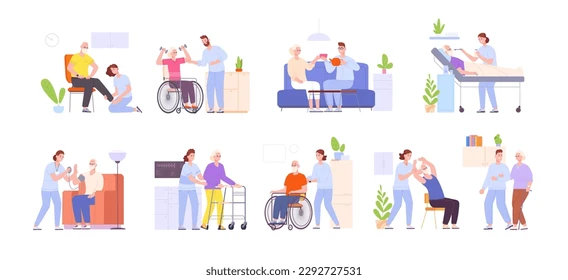
As the global population ages, families increasingly face the challenge of providing quality care for their elderly loved ones. Professional elder care services can be expensive, with average annual costs for in-home services reaching $61,776 in the U.S. (Source: Genworth). However, affordable alternatives exist that ensure seniors receive the care and support they need without straining family finances. Here’s a guide to low-cost options for elderly home care, with practical solutions and resources to help families plan effectively.
Why Home Care is Essential
Home care allows elderly individuals to maintain their independence and dignity while staying in a familiar environment. Studies show that aging in place improves mental health and prolongs life expectancy. For families, however, balancing cost and quality is crucial.
Affordable Elderly Home Care Options

1. Hiring Personal Care Assistants (PCAs)
- What They Do: PCAs help with daily activities like bathing, dressing, cooking, and light housekeeping.
- Cost: On average, PCAs charge $15–$25/hour, significantly lower than skilled nurses.
- Tip: Look for PCAs through local community centers or classified ads to find budget-friendly options.
2. Using Family and Community Resources
- Family Support: Involve multiple family members to share caregiving duties.
- Volunteer Programs: Nonprofits like Meals on Wheels provide free meal deliveries to seniors, reducing caregiver workload.
- Local Charities: Some organizations offer free or subsidized transportation and companionship services.
3. Leveraging Medicaid and Medicare

- Medicaid: Covers home health aides, medical equipment, and sometimes personal care services.
- Medicare: Provides short-term care for medical needs like physical therapy or wound care.
- How to Apply: Contact your local social services office or visit Medicare/Medicaid websites for eligibility details.
Highlight: Check if your loved one qualifies for a Medicaid waiver, which can significantly reduce out-of-pocket expenses.
4. Exploring Adult Daycare Programs
- What They Offer: Structured activities, meals, and socialization during the day.
- Cost: Typically costs $70 per day, far less than in-home care or nursing facilities.
- Ideal For: Seniors who need supervision but do not require round-the-clock care.
5. Technology for Remote Care
- Health Monitoring Devices: Wearables like Fitbit or MedMinder track vitals and medication schedules.
- Telehealth Services: Virtual consultations with doctors and specialists save time and travel costs.
- Emergency Alert Systems: Devices like Life Alert ensure quick responses during emergencies.
Step-by-Step Instructions for Affordable Elder Care
Step 1: Assess Care Needs

Determine your elderly parent’s level of care by considering:
- Mobility and daily activity assistance needs.
- Medical requirements like medications or therapies.
- Emotional and social engagement preferences.
Step 2: Budget Planning
- List all potential expenses, including PCA wages, transportation, and medical costs.
- Identify financial assistance programs like veteran benefits or local grants.
Step 3: Research Local Resources
- Check local senior centers for free or low-cost services.
- Use tools like Eldercare Locator to find community programs.
Step 4: Combine Solutions
- Mix professional care with family caregiving to balance costs and coverage.
- Use adult daycare on workdays and family caregiving on weekends.
Step 5: Review Regularly
Care needs evolve, so review the plan every 3–6 months and make adjustments as necessary.
Real-Life Example: Caregiving on a Budget
Linda, a working mother of two, cared for her aging father with Alzheimer’s. She combined:
- Medicaid assistance for medical supplies.
- Local volunteer programs for companionship.
- An adult daycare center three days a week, costing her just $210 weekly compared to $600 for full-time home care.
Financial Aid Options
| Program | Benefits | How to Access |
|---|---|---|
| Medicaid Waivers | Covers home and personal care | Apply via state Medicaid office |
| Veterans Affairs (VA) | Home-based primary care for veterans | Contact local VA office |
| Area Agencies on Aging | Free services like meal delivery | Visit Eldercare.gov |
| Nonprofit Organizations | Subsidized transportation, food | Search local charity directories |
How to Save on Home Care Costs

Opt for Part-Time Help
Instead of full-time care, hire help for a few hours daily or weekly.
Group Services
Share professional caregivers with other families to split costs.
Tax Benefits
Claim tax deductions for caregiving expenses under the Dependent Care Credit.
Caring for elderly parents at home doesn’t have to break the bank. With careful planning, leveraging community resources, and embracing technology, families can provide quality care while keeping costs low. Affordable solutions like PCAs, Medicaid programs, and adult daycare centers ensure your loved ones age comfortably and with dignity.
FAQs
1. Can I get paid to care for my elderly parent?
Yes, some Medicaid programs and long-term care insurance plans offer caregiver compensation.
2. What’s the cheapest way to provide eldercare?
Combining family caregiving with community resources like Meals on Wheels and adult daycare is cost-effective.
3. Are there grants for elderly home care?
Yes, many local governments and nonprofits provide eldercare grants. Search for options in your area.
4. How does Medicare help with home care?
Medicare covers short-term home health care services for medical needs like therapy and wound care.
5. Are there online resources to find low-cost care?
Websites like Eldercare Locator and Caring.com offer databases of affordable services near you.






